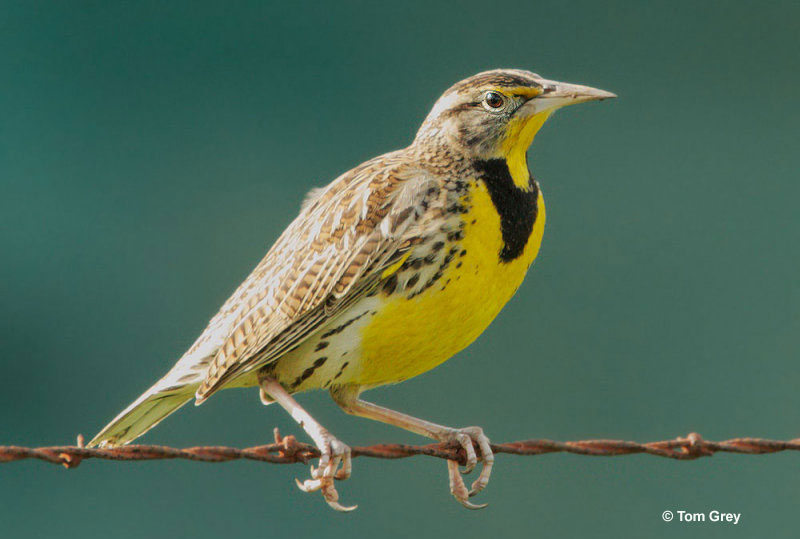
Wyoming is a big western state with 97,914 square miles of open lands, sagebrush, mountains, and other wild and scenic habitats. Nearly 577,000 people share these beautiful places with an impressive 450 bird species!
Wyoming state bird is the Western Meadowlark. But do you know why this bird was chosen as their state bird?
On this page
State Bird of Wyoming
The Western Meadowlark (Sturnella neglecta) became Wyoming’s state bird on February 5th, 1927. This is the date when the Wyoming State Legislature voted to make it an official state symbol.
Although they only voted to choose the Meadowlark, since the Western Meadowlark is the only meadowlark species in Wyoming, it’s safe to say they were referring to that species.
The reasons and process for picking the Western Meadowlark were similar to most other states. During the 1920s and 1930s, one of the main goals of Federated Women’s Clubs was having every state pick an official state bird and other state symbols.
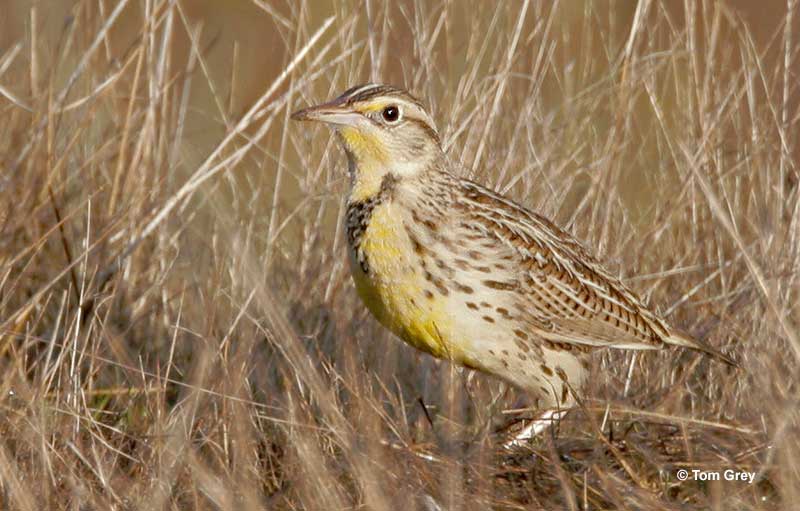
They usually worked with local Audubon clubs, garden clubs, and other organizations to choose a suitable candidate and then convinced lawmakers to hold an official vote. During the process, they also frequently organized elections for state birds in local schools.
In the case of Wyoming, the state legislature didn’t have any problem holding a session to choose an official state bird. They were also sure about which bird to pick, right from the start. In Wyoming, the Western Meadowlark is probably the most common beautiful songbird in the state.
Go for a walk or watch birds in Wyoming, and you can’t miss this bird’s beautiful song and bright yellow colors!
Fun Facts about Western Meadowlarks
- At one time, the Western Meadowlark was believed to be the same species as the Eastern Meadowlark. Both species do look very similar and can even hybridize. However, they also differ in their plumage, song, and habitats. In 1844, John James Audubon noticed these differences and proposed recognizing the Western Meadowlark as a valid species.
- Despite their name, the Western Meadowlark is a blackbird species. They might act like larks, but they are more closely related to grackles, orioles, cowbirds, and other members of the Icteridae family.
- In the past, farmers were concerned that the Western Meadowlark might damage their crops. They often saw it in their farm fields and feared it was feeding on their grain. However, their worries were converted to relief when studies showed that the Western Meadowlark is a beneficial bird that feeds on crop pests.
- Western Meadowlarks build their nests on the ground but hide them very well. They even construct a domed cover on top of their nest to protect and hide it from threats. In addition, their nests have entrance tunnels that can be several feet long.
- In common with other blackbird species, Western Meadowlarks do “gaping” behavior with their beak. They stick their sharp bill into the ground and then open it to loosen up dirt and vegetation. This helps them find hidden insects and seeds.
- Kansas, Montana, Nebraska, North Dakota, and Oregon have the Western Meadowlark as their state bird, too.
Identification
The Western Meadowlark is a rotund bird species with a mostly white tail, longish pink legs, and a long, sharp beak. It’s a bit larger than a European Starling and measures 9.5 inches long. It also has a wingspan of 14.5 inches, and weighs 3.4 ounces.
This blackbird is mostly pale brown and yellow and has a large black “V” mark on its chest. They have bright yellow in front of their eyes, on their throat, and on most of their underparts. This species also has some yellow on the lower part of its face. This particular feature can be an important field mark to help identify it from the very similar Eastern Meadowlark.
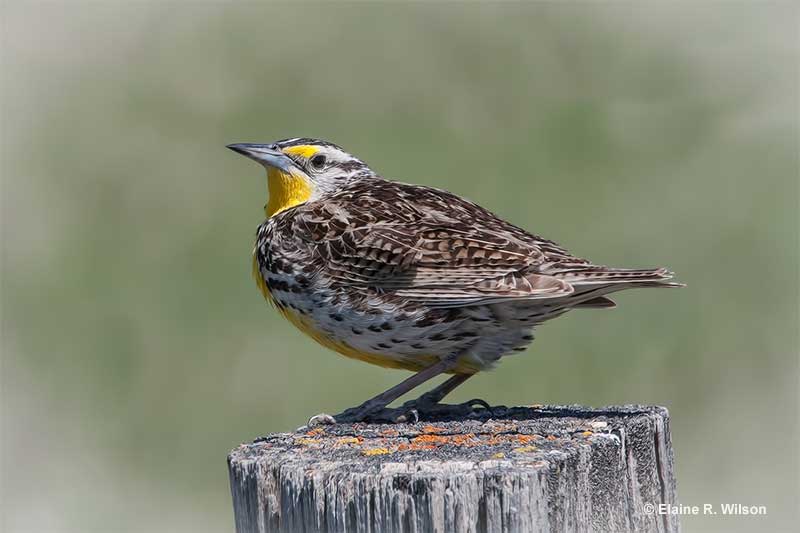
Western Meadowlarks are pale brown above with mottling and some streaks. They also have small black markings on their white sides, fine streaks on their dark crown, a pale gray face, and a prominent black line that goes back from each eye.
Both sexes of the Western Meadowlark look the same, but males are slightly larger. Males are also brighter, especially during spring. However, these differences can be really difficult to notice in the field. Young birds and winter adults are paler overall.
What do Western Meadowlarks eat?
Western Meadowlarks eat lots of insects, other invertebrates, and various seeds. They feed on insects like crickets, grasshoppers, beetles, ants, and just about any other small creature they can catch.
This blackbird species forages for bugs and other arthropods by strolling in open places with sparse grass. As it steadily walks along, the bird watches for insects in the grass and on the ground.
When a Western Meadowlark notices an insect or other small creature, the bird quickly moves to snatch it with its beak. It also uses its sharp bill to poke into grass, and other vegetation, straight into the ground. After poking its beak, the bird opens it to reveal hidden seeds and insects.
Western Meadowlarks also use their beaks to move small rocks, dried manure, and bits of vegetation.
This meadowlark species also forages for some seeds, especially during the winter. They feed on seeds by picking them from grass, other short plants, and right from the ground. Sometimes, Western Meadowlarks also feed on the eggs and nestlings of other bird species!
They only occasionally do this, and probably when the parent birds aren’t there to protect their nest.
In winter, Western Meadowlarks have also been seen scavenging carrion!
Call
The Western Meadowlark is a vocal bird that frequently calls and sings. Both sexes make rattling calls, especially in flight. When alarmed, they also make loud “chup!” calls.
However, these pretty birds are best known for the male’s pleasant, whistled, flute-like warbling song. It sounds like “rip TEE-tur, ripadip.”
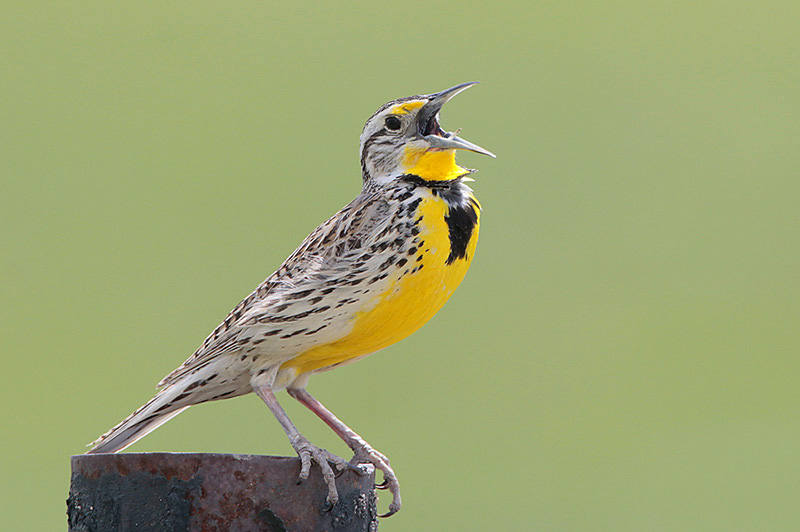
We can hear their beautiful whistled song throughout the year, but the birds sing most often during spring and summer.
Male Western Meadowlarks can sing while standing on the ground but usually sing from the top of a bush, pile of rocks, or fence post.
Behavior
Western Meadowlarks are pretty easy to see and common in farm fields, pastures, short-grass prairie, and other open habitats. It’s especially easy to notice singing male Western Meadowlarks.
These conspicuous birds also walk on open ground, perch on top of bushes and other prominent spots, and frequently chase each other in flight.
In spring and summer, we usually notice them as they sing, or as pairs forage near each other. However, during the fall and winter months, Western Meadowlarks can form small flocks. They forage in the same field but always keep some distance from each other.
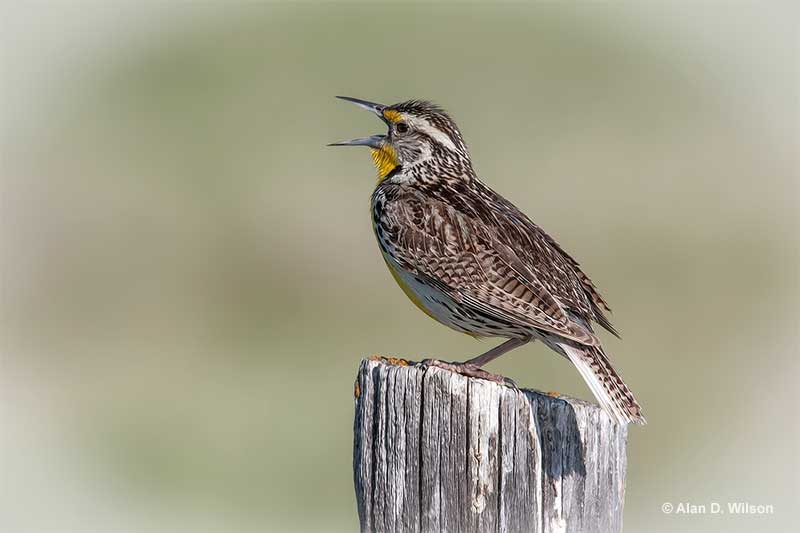
Western Meadowlarks fly with quick, buzzy wing beats followed by brief glides. When they fly low over the ground, they can look sort of like a quail that has a white tail.
The Western Meadowlark can attack nests of sparrows and other small birds, but it’s not a threat to pets or people. This species actually has to be very careful of the many predators that catch them. They include various hawks, owls, cats, and other carnivores.
Keep reading – Most common birds of Wyoming
Frequently Asked Questions
What is the state bird of Wyoming?
The state bird of Wyoming is the Western Meadowlark.
Why is the Western Meadowlark the state bird of Wyoming?
The Western Meadowlark is the state bird of Wyoming because it is one of the most beautiful and well-known birds in the state.
When did Wyoming choose its state bird?
Wyoming chose its state bird on February 5th, 1927.
What other states have the Western Meadowlark as their state bird?
The other states that have the Western Meadowlark as their state bird are Kansas, Montana, Nebraska, North Dakota, and Oregon.
What is Wyoming’s state animal?
Wyoming’s state animal is the American Bison.
What is the state flower of Wyoming?
The state flower of Wyoming is the Wyoming Indian Paintbrush, or Painted Cup.

